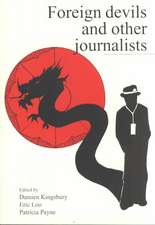Effective Civil-Military Interaction in Peace Operations: Theory and Practice
Editat de Gerard Lucius, Sebastiaan Rietjensen Limba Engleză Hardback – 4 apr 2016
| Toate formatele și edițiile | Preț | Express |
|---|---|---|
| Paperback (1) | 698.15 lei 6-8 săpt. | |
| Springer International Publishing – 24 apr 2018 | 698.15 lei 6-8 săpt. | |
| Hardback (1) | 704.50 lei 6-8 săpt. | |
| Springer International Publishing – 4 apr 2016 | 704.50 lei 6-8 săpt. |
Preț: 704.50 lei
Preț vechi: 828.82 lei
-15% Nou
Puncte Express: 1057
Preț estimativ în valută:
134.81€ • 141.40$ • 112.22£
134.81€ • 141.40$ • 112.22£
Carte tipărită la comandă
Livrare economică 01-15 aprilie
Preluare comenzi: 021 569.72.76
Specificații
ISBN-13: 9783319268040
ISBN-10: 331926804X
Pagini: 310
Ilustrații: XXVII, 295 p. 51 illus. in color.
Dimensiuni: 155 x 235 x 24 mm
Greutate: 0.63 kg
Ediția:1st ed. 2016
Editura: Springer International Publishing
Colecția Springer
Locul publicării:Cham, Switzerland
ISBN-10: 331926804X
Pagini: 310
Ilustrații: XXVII, 295 p. 51 illus. in color.
Dimensiuni: 155 x 235 x 24 mm
Greutate: 0.63 kg
Ediția:1st ed. 2016
Editura: Springer International Publishing
Colecția Springer
Locul publicării:Cham, Switzerland
Public țintă
ResearchCuprins
Chapter 1. Getting Better at Civil-Military Interaction; Sebastiaan Rietjens and Gerard Lucius.- Chapter 2. Civil-military Interaction: Rationale, Possibilities and Limitations; Cedric de Coning.- Chapter 3. Who are they? – Encountering International and Local Civilians in Civil-Military Interaction; Georg Frerks.- Chapter 4. Civilians in Military Operations: Blue on Blue; Jeannette Seppen and Gerard Lucius.- Chapter 5: Preparation Starts at Home: Education and Training for Civil-Military Interaction Kelisiana Thynne and Gwen Cherne.- Chapter 6. Obtaining Population Centric Intelligence: Experience of the Netherlands Military Presence in South Afghanistan; Martijn Kitzen and Willem Vogelsang.- Chapter 7. Civil-Military Planning; Philip Shetler-Jones.- Chapter 8. Just in time: Civil-Military Logistics; Maggie Heraty.- Chapter 9. Reconstructing the Infrastructure of Damaged Societies; Garland H. Williams.- Chapter 10. Civil-Military Interaction during Infantry Operations; John Melkon, James Embrey, Harry Bader and Brian Mennes.- Chapter 11. Military’s Engagement in Civilian Healthcare; Sebastiaan Rietjens and Myriame Bollen.- Chapter 12. CIMIC Projects: Divergent Interests, Convergent Action; Gerard Lucius.- Chapter 13. Dealing with Cultural Differences; Paula Holmes-Eber.- Chapter 14. Fighting Corruption in Conflict Areas; Saad Mustafa, Tobias Bock and Mark Pyman.- Chapter 15. Human Rights and Refugee Protection: The Interface with Humanitarian Actors; Christine Mougne and Fedde Groot.- Chapter 16. Leadership and the Comprehensive Approach; Peter Olsthoorn and Joseph Soeters.- Chapters 17. Civil-Military Interaction, CIMIC and Interacting with Gender; Gunhild Hoogensen Gjorv anf Toiko Tönisson Kleppe.- Chapter 18. Improving Evaluation of Civil-Military Cooperation; Peter Essens and Thom de Vries.- Chapter 19. Civil-Military Interaction: From Practice to Theory; Sebastiaan Rietjens.
Notă biografică
Gerard Lucius joined the DiplomaticService of the Netherlands in 1997 and civil-military interaction has been aconstant in his career. He was the Liaison Officer to the Netherlands Ministryof Defence during various operations in the Former Yugoslavia and a DevelopmentAdviser to the Commander of Task Force Uruzgan, the Dutch contribution to ISAF.As a consultant to the United Nations Mission in Sudan (UNMIS) before theindepence of South Sudan, he coordinated donor support to the Joint IntegratedUnits of Sudanese Army and SPLM. He also worked as Political Secretary andEconomic Secretary in Zambia and Qatar, respectively. Since 2002, Gerard spendsa number of weeks annually as an active reserve officer in 1 (NL)Civil-Military Interaction Command, where he is a Senior Consultant in theCommand’s Political Network. Gerardwas Counselor and Deputy Head of Mission of his country's embassy in Baghdadfrom 2012-2014. He currently works on Antiterrorism and National Securityissues at the Dutch Ministry of Foreign Affairs in The Hague.
Dr. Sebastiaan Rietjens, an engineer by training, is an associate professor at the Netherlands Defense Academy, and a reserve major in the Netherlands army. He has done extensive fieldwork in military operations and has published accordingly in international journals and books. His main focus of interest is on civil-military interaction, effectiveness of military operations as well as logistics and information management. He co-edited volumes on civil-military cooperation (Ashgate, 2008) and research methods in studies (Routledge, forthcoming) and a special issue on defense logistics (International Journalof Physical Distribution and Logistics Management, 2013). Sebastiaan is a regular speaker at the Cimic Centre of Excellence and the NATO School and has given presentations at numerous institutions and (academic) conferences including the Australian Defence Forces Academy, the European Committee on Security and Development and the US Marine Corps University.
Dr. Sebastiaan Rietjens, an engineer by training, is an associate professor at the Netherlands Defense Academy, and a reserve major in the Netherlands army. He has done extensive fieldwork in military operations and has published accordingly in international journals and books. His main focus of interest is on civil-military interaction, effectiveness of military operations as well as logistics and information management. He co-edited volumes on civil-military cooperation (Ashgate, 2008) and research methods in studies (Routledge, forthcoming) and a special issue on defense logistics (International Journalof Physical Distribution and Logistics Management, 2013). Sebastiaan is a regular speaker at the Cimic Centre of Excellence and the NATO School and has given presentations at numerous institutions and (academic) conferences including the Australian Defence Forces Academy, the European Committee on Security and Development and the US Marine Corps University.
Textul de pe ultima copertă
This book contains unique, firsthand experiences of both the military and civilian actors involved in civil-military interaction processes. It presents lessons learned from a variety of situations, from both NATO-led operations and UN Integrated Missions, and in different geographical areas, such as the Balkans, Iraq, Afghanistan and Africa. Rather than taking the improvisational approach, these lessons learned will enable military commanders and staff and their civilian counterparts in governments, International Organisations and NGOs to come fully prepared for the challenges of today's multifaceted missions. With a better understanding of the mandates and methods of the various civilian and military actors comes greater respect for each other's comparative advantages. With respect comes smoother cooperation. And with that, efficiency gains and enhanced overall mission effectiveness. Each chapter contains solid analysis and advice, specific to the functions found in military organizations, from Intelligence to Personnel and from Logistics to Engineering. Cross-cutting themes like Gender, Human Rights and Corruption are also included in this work that brings together some of the best that practitioners and academics can offer.
Caracteristici
Makes knowledge on civil-military interaction explicit and widely applicable Counters the improvisational, pragmatic and ad hoc approach to civil-military interaction Provides tailored information for those working in intelligence, logistics, engineering, operations, planning, and personnel or as Commanding Officers?








